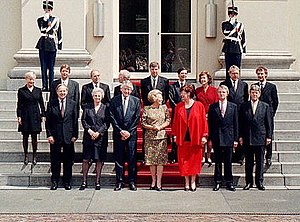Second cabinet Kok
| Second Kok cabinet Second Purple cabinet |
|
|---|---|
|
63rd cabinet of the Netherlands |
|

The installation of the Second Kok cabinet on 3 August 1998
|
|
| Date formed | 3 August 1998 |
| Date dissolved | 22 July 2002 (Demissionary from 16 April 2002) |
| People and organisations | |
| Head of state | Queen Beatrix |
| Head of government | Wim Kok |
| Deputy head of government |
Annemarie Jorritsma Els Borst |
| No. of ministers | 14 |
| Ministers removed (Death/resignation/dismissal) |
2 |
| Total no. of ministers | 18 |
| Member party |
Labour Party (PvdA) People's Party for Freedom and Democracy (VVD) Democrats 66 (D66) |
| Status in legislature | Majority government (Purple) |
| Opposition party | Christian Democratic Appeal |
| Opposition leader |
Jaap de Hoop Scheffer (1998–2001) Jan Peter Balkenende (2001–2002) |
| History | |
| Election(s) | Dutch general election, 1998 |
| Outgoing election | Dutch general election, 2002 |
| Legislature term(s) | 1998–2002 |
| Incoming formation | 1998 Dutch cabinet formation |
| Outgoing formation | 2002 Dutch cabinet formation |
| Predecessor | First Kok cabinet |
| Successor | First Balkenende cabinet |
The Second Kok cabinet, also called the Second Purple cabinet was the executive branch of the Dutch government from 3 August 1998 until 22 July 2002. The cabinet was formed by the political parties Labour Party (PvdA), People's Party for Freedom and Democracy (VVD) and the Democrats 66 (D66) after the Dutch general election of 1998. The cabinet was a majority cabinet in the House of Representatives.
The new cabinet was the successor of the First Kok cabinet (First Purple cabinet) and was formed from the same coalition of Labour Party, People's Party for Freedom and Democracy and Democrats 66. It was also known as the 'tweede paarse kabinet' ('second purple cabinet') called such because it contained both the social-democratic Labour Party (red) and the liberal People's Party for Freedom and Democracy (blue).
The aim of the cabinet was to continue the policy of cabinet Kok I, which was concerned with economizing, tax reduction and making an end to unemployment. Wim Kok was the Prime Minister, Annemarie Jorritsma as the Deputy Prime Minister for the People's Party for Freedom and Democracy, and Els Borst for Democrats 66. The cabinet was considered boring, because both left-wing and right-wing political parties were a part of it. There was no strong opposition in the parliament. The cabinet completed processes of liberalisation which were started by the previous cabinet: the legalisation of prostitution in 2000, same-sex marriage in 2001 and Euthanasia in 2002. This cabinet was notable for resigning twice. The first time was in May 1999, when Democrats 66 stepped out of the coalition when proposed legislation entered by this party was blocked; through negotiations the crisis was solved and the cabinet stayed together. The second and final time was on 16 April 2002, just one month before the next election, when Prime Minister Kok wished to resign over the NIOD report into the genocide of Srebrenica in 1995 and the other ministers had no choice but to follow him. The Second Kok cabinet remained in place as a Demissionary cabinet until 22 July 2002, when it was replaced by the First Balkenende cabinet.
...
Wikipedia
